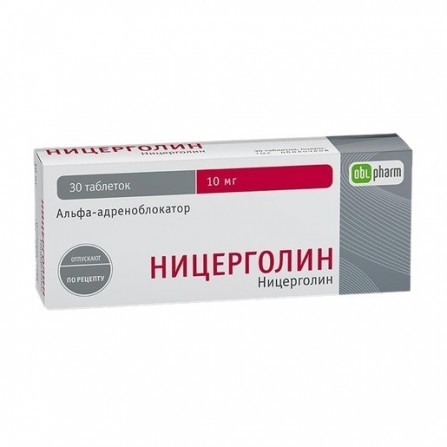Nicergolin coated pills 10mg N30 obl
Condition: New product
1000 Items
Rating:
Be the first to write a review!

More info
Active ingredients
Nicergolin
Release form
Pills
Composition
Nitroglycerin 10 mg
Pharmacological effect
Alpha blocker. Improves cerebral circulation, activates the metabolism of the brain. It reduces the resistance of cerebral vessels, increases arterial blood flow and the consumption of oxygen and glucose by brain tissues. Reduces the resistance of pulmonary vessels. Increases blood flow velocity in the vessels of the upper and lower extremities, especially when blood circulation is disturbed. Reduces platelet aggregation and improves hemorheological parameters. In patients with arterial hypertension, it may cause a gradual decrease in blood pressure.
Pharmacokinetics
After ingestion nicergoline is rapidly and almost completely (90-100%) absorbed from the gastrointestinal tract. Cmax of nicergoline in blood plasma is achieved in 1-1.5 h; Metabolized by hydrolysis, dimethylation and glucuronization. There are 3 metabolites of nicergoline, the main of which is 6-methyl-8β-hydroxymethyl-10-methoxyergoline .; 70-80% of nicergoline and its metabolites are excreted by the kidneys for 70-100 hours after ingestion. 20% nicergoline is excreted .; Nicergoline T1 / 2 in healthy volunteers is 2.5 h, the main metabolite is 12-17 h.
Indications
Acute and chronic insufficiency of cerebral blood circulation (including atherosclerosis of cerebral vessels, dynamic disorders of cerebral circulation, thrombosis and embolism of cerebral vessels), migraine, obliterating vascular diseases of extremities, Raynaud’s disease, arterial hypertension and hypertensive crisis (as an aid) .
Contraindications
Acute bleeding, recent myocardial infarction, arterial hypotension, severe bradycardia, simultaneous use of alpha and beta-blockers, pregnancy, lactation, hypersensitivity to nicergoline.
Use during pregnancy and lactation
Nicergoline is contraindicated for use during pregnancy and lactation (breastfeeding).
Dosage and administration
Install individually. Inside - 5-10 mg 3 times / day, the course of treatment - 2-3 months or more .; V / m - 2-4 mg 2 times / day. A single dose with a / drip is 4-8 mg, with a / a - 4 mg.; In some cases, at the beginning of treatment, they are administered intramuscularly or intravenously, then orally as a supportive therapy.
Side effects
Since the cardiovascular system: orthostatic hypotension and dizziness (especially after IM or IV), fainting, redness of the skin of the face .; From the side of the central nervous system: sleep disorders, agitation, drowsiness, insomnia, anxiety, increased sweating .; On the part of the digestive system: nausea, diarrhea, increased acidity of gastric juice, abdominal pain, decreased appetite .; Allergic reactions: erythema, urticaria.
Overdose
Symptoms: transient pronounced decrease in blood pressure. Treatment: Special treatment is usually not required, it is enough to lay the patient in a horizontal position for a few minutes, in exceptional cases, with a sharp disturbance in the blood supply to the brain and heart, it is recommended to administer sympathomimetic drugs under constant monitoring of blood pressure.
Interaction with other drugs
With simultaneous use with antihypertensive agents, antihypertensive effect is enhanced .; With simultaneous use increases the effect of indirect anticoagulants and antiplatelet agents.
special instructions
Correction of the dosage regimen is required for patients with renal failure and elderly patients with a serum creatinine level of more than 2 mg / dl .; After intramuscular or intravenous administration of nicergoline, the patient must be in a horizontal position for a few minutes .; With long-term therapy, patients should be examined at least once every 6 months, with the aim of possibly reducing the dose or canceling nicergoline.


